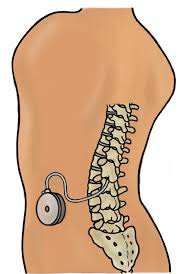Case study
I am a 54-year-old male with secondary progressive MS. I am not on a disease-modifying therapy at present. I was on fingolimod, but it was stopped two years ago when I started using a wheelchair. I have severe marked spasticity in my legs despite taking baclofen 20 mg three times a day. I take my first dose of baclofen at about 8 am, the second at 3 pm, and the third before bed at night, between 10 and 11 pm. Despite this, I get severe breakthrough spasms that wake me at about 3-4 am in the morning. I also find the baclofen very sedating during the day. Is there anything I can do to help with the spasms and reduce my sedation?

Prof G’s opinion
Unfortunately, we don’t have any oral drugs that work on spasticity that don’t have off-target effects that include sedation and, sadly, cognitive slowing. Baclofen is a very old drug that was developed in the 1960s as an anti-seizure drug and repurposed in the 1970s to treat spasticity. Baclofen works by stimulating a receptor called the GABA-B receptor. GABA is the primary inhibitory neurotransmitter in the central nervous system (CNS).
Baclofen has a very narrow therapeutic window, i.e. you have to achieve relatively high blood levels to achieve an anti-spastic effect, which is at a similar level that causes sedation and cognitive slowing. Baclofen also has a short half-life that varies between individuals and falls between 2-6 hours. A half-life refers to the time it takes for blood levels to fall by half. The short half-life means baclofen has to be taken frequently; otherwise, you get wearing-off effects, i.e. spasticity returns before the next dose. Some patients have to take baclofen 4-6 times a day. Wearing off is particularly prominent at night when it intersects with the diurnal (day-night) variation in spasticity. Spasticity is naturally worse in the early morning hours (4-6 am), and when this coincides with baclofen levels dropping, spasms become more prominent and uncomfortable.
Add-on antispastic agents
One solution would be to take baclofen as a slow-release formulation to lengthen its half-life. A slow-release formulation has been developed but is unavailable in Europe or the UK. This patient can either increase his baclofen dose and take it four times a day, with an additional dose between 2 and 3 am in the morning or take an add-on antispastic agent with a longer half-life that covers the 4-8 am time window. Many pwMS with frequent waking choose to wake up to take an additional dose of baclofen in the early hours of the morning. If not, I tend to add on clonazepam starting at 0.5 mg at bedtime, increasing by 0.5 mg every few weeks until the patient gets to 2 mg or there is an adequate therapeutic response. Some patients need even higher doses.
Please note clonazepam is a benzodiazepine that works on the GABA-A receptor and is associated with a phenomenon called tachyphylaxis. Tachyphylaxis is a diminishing response to successive doses of a drug, rendering it less effective. A 0.5 mg initial dose may stop working after a few days or weeks, and a higher dose may be needed.
Please be aware that tachyphylaxis happens with a large number of drugs working on the CNS and can be due to metabolism, i.e. the drug induces the liver to be more effective at breaking down or metabolising the drug, or it downregulates its effects on the receptor in the CNS or the CNS upregulates the number of receptors, therefore, higher doses of the drug are required to have the same effect. The effects of tachyphylaxis are reversed when you have a drug holiday, and that is why if you restart the drug, a period of re-titration is required.
A common cause of opioid deaths in people with opioid addiction is because of this phenomenon; i.e. after a period of abstinence, they relapse, and instead of using a lower dose, they go back to the same dose they were using before, which causes CNS suppression and they have a respiratory arrest. The most dangerous time for opioid abusers to overdose is when they resume using the drug after a period of abstinence. If you know someone who uses or abuses opioids, please tell them about this phenomenon.
The compensatory mechanisms resulting from taking antispastic agents mean you can have a severe rebound or augmented spasticity if you stop taking them suddenly. In this situation, the spasticity is much worse than before starting the specific anti-spastic agent.
If clonazepam does not work or is poorly tolerated, this patient could try one of the gabapentinoids (gabapentin or pregabalin) or add-on Sativex or THC. Please be aware that all add-on agents with a longer half-life can cause a hang-over effect, i.e. you feel groggy and slow in the morning. In my experience, most people get used to the hangover effect with time.
A general principle with anti-spastic agents is gradually increasing the dose slowly over weeks to months. This gradual titration allows you to get used to the sedation and other side effects of the drugs. Anybody who has started taking high doses of anti-spastic agents initially or titrates up the dose too quickly will know what I mean.
Ragdoll effect
People who have a lot of weakness and use their lower limbs as splints to mobilise and sometimes walk often go off their feet when they start anti-spastic agents. This is because they lose tone in their legs, which then collapse. This is why some pwMS prefer to live with their spasticity. Others only take antispastic agents at night, knowing that the ragdoll effect is reversible and accept not being able to walk at night but relying on the drug wearing off so they can mobilise in the morning.
If you have a lot of leg weakness, you must be careful when starting antispastic agents. Due to the ragdoll effect, many pwMS have fallen when getting out of bed at night. This can be a problem if you live alone, particularly if you don’t have enough strength to get up. One of my patients had to lie on the floor for 5 hours before his carer came in to help him get off the floor. This is another reason for purchasing and wearing a community alarm at night.
Please be aware the ragdoll effect can affect the trunk in wheelchair users and result in pwMS slumping forwards or sideways in the wheelchair. In people with more advanced MS, it can result in the head flopping forwards, backwards, or to the side.
Intrathecal baclofen
Finally, if all else fails, a baclofen pump may be required. This is when a catheter is inserted into the lumbar sac, and a low but continuous dose of baclofen is infused into the spinal fluid. This is an expensive and invasive procedure, but it can significantly improve the quality of life of a pwMS with severe spasticity. The good thing about intrathecal baclofen is that it works locally at the level of the spine and spares the brain. This means the person benefits from baclofen without the sedation and cognitive slowing. This advantage of intrathecal baclofen can’t be underestimated. Being able to wean high doses of oral antispastic agents often results in patients waking up from a state of perpetual sedation. One of my mentors used to refer to these patients as being baclofen zombies because of their inability to function due to excessive sedation. I suspect many of you on high doses of anti-spastic agents will relate to this.
I relate to this. After my accident, when I was on gabapentin and morphine, I was unable to function cognitively. I would have to read something twice or three times to understand it, and even then, my memory was poor. My concentration span was limited to 15 to 20 minutes. It was only after weaning both the gabapentin and morphine that I realised how disabling these drugs can be. Zombification from anti-spastic agents is one of the indications for referral for a baclofen pump. This is particularly relevant for pwMS who need to function cognitively. It is amazing to see how much cognition improves when you do formal cognitive testing before and after the insertion of a baclofen pump insertion and weaning oral antispastic agents (see the research paper below).
Other antispastic agents
Some of you may be on tizanidine, another licensed anti-spastic agent. I don’t find this drug to be that effective. It is often needed in very high doses to have an antispastic effect, and again, it is very sedating. I very rarely prescribe it.
Dantrolene is an old antispastic agent that works at the level of the muscle and not the CNS. Despite its appealing mode of action, it is associated with many CNS side effects, which include depression, a confusional state, anxiety, hallucinations, disorientation, dizziness, altered taste, seizures and insomnia. It can be hepatotoxic, and liver function needs to be monitored regularly. Due to all these factors, I rarely use it in my clinical practice, but some patients may need it when all else fails.
The cannabinoids help spasticity, but we have a problem prescribing them on the NHS. Sativex spray, which contains tetrahydrocannabinol (THC) and cannabidiol (CBD), can be a very effective adjunct to other antispastic agents. Sativex is particularly effective at night and helps with nocturnal spasms and insomnia. Please be aware that there is no actual therapeutic window where you get the anti-spastic effects of THC without the dysphoric or euphoric effects. This is why many pwMS who find Sativex and other cannabinoids effective stop taking them.
Other benzodiazepines, including diazepam and clobazam, are sometimes used as antispastic agents. From my experience, these don’t have an advantage over clonazepam.
Finally, anti-seizure drugs, including sodium channel blockers, may impact spasticity. I have often started a sodium channel blocker (carbamazepine, oxcarbazepine, lamotrigine, phenytoin) for pain, and patients have reported that their spasticity has improved or they have noticed the ragdoll effect. I don’t prescribe these drugs for spasticity, but their effect on spasticity is worth noting.
Physical therapies
Exercise, including both active and passive movements, can help spasticity. This is why seeing a physiotherapist is an essential part of spasticity management. I have many patients who manage their spasticity with exercise and stretching alone. So please don’t underestimate the physiotherapist's role in spasticity management.
Some patients may benefit from botox injections into specific muscles to control spasticity locally. For example, weakening the adductor or thigh muscles that close the legs can allow for better perineal hygiene and intermittent catheterisation. Rarely can you inject phenol into the spinal canal to permanently destroy the sensory nerves, or you can cut the nerves (rhizotomy) to achieve the same effect. Destroying the sensory nerves breaks the feedback loop essential for the spinal reflex and spasticity.
Time course
Spasticity often takes time to develop. For example, if you have a severe spinal cord relapse with weakness in the legs, the legs may be initially floppy. Then over months or years, the legs start to become spastic. This delayed ramping up of spasticity over time tells us the central mechanism causing spasticity is due to the remodelling of spinal cord neuronal circuits. I have also seen the opposite, with spasticity improving with time. Again, the mechanisms causing this must be due to CNS plasticity and the rewiring of neuronal circuits.
Other factors
Please be aware that constipation, urinary retention, infections, pressure sores, poor-fitting orthotics, menstruation, menopause, sleep deprivation, high and low ambient temperatures, pain and other factors can worsen spasticity. Most pwMS become aware of these exacerbating factors with time. Some people even use their spasticity as an early warning sign of a urinary tract infection (UTI).
I highlight these extraneous factors because the management of spasticity in pwMS is complex and often requires a multidisciplinary team to optimise its management. For example, it is not good to focus on spasticity if the underlying problem is faecal impaction or a urinary tract infection.
Too often, spasticity needs to be better managed. Poorly controlled spasticity can have a major impact on your quality of life. If you feel your spasticity is being poorly managed, don’t accept it. Contact your HCP so you can have a spasticity review.
Please share your experiences and spasticity management hacks. What do you do to improve your spasticity management? How many of you are baclofen, gabapentin, pregabalin, clonazepam, tizanidine or dantrolene zombies? The study below demonstrates the reversal of this state after the implantation of a baclofen pump. Do you need to be assessed for a baclofen pump?
Paper
Background: Spasticity is a common problematic symptom in Multiple Sclerosis with over one third of patients failing first line therapies. Intrathecal baclofen is a safe and efficacious option for treatment resistant spasticity. Anecdotally patients report improved concentration/cognitive performance when switching to intrathecal baclofen (ITB) from systemic medications.
Aim: To explore whether subjects who proceed with ITB pump implantation for spasticity management and reduce oral anti-spasticity agents will have improved cognitive function.
Methods: Subjects were admitted for trial of ITB via lumbar puncture and subsequent pump implantation. Spasticity and cognitive measures before ITB trial and 3 months post implant were recorded. Paired t-test or Wilcoxon Signed Ranks test was used for within subject change and effect sizes (Cohen's dz) were calculated. Subgroup analysis of those on ≥2, or ≤ 1 spasticity medications at baseline was performed.
Results: 27 subjects with MS completed per protocol. Mean age 46 years [26 - 56], disease duration 15 years [6 - 26], RRMS = 3, SPMS = 17 and PPMS=7. The majority were on multiple spasticity medications. Spasticity scores significantly improved post pump implant. Mean ITB dose at 3 months was 143 mcg / day and 19 discontinued all other treatments for spasticity. There was no deterioration on any cognitive or mood measure. An improvement of moderate effect size was found in Backwards Digit Span (d=0.41, p=0.059) and HADS - anxiety (d=0.37, p=0.097). Fatigue Severity Scale score decreased substantially (d=0.81, p=0.005). Small improvements in Symbol Digit Modalities Test score (d=0.24) and Sustained Attention to Response Task response time (d=0.23) were non-significant. Performance on other measures did not change. Effect sizes were larger in subgroup on ≥2 oral spasticity medications at baseline, compared to the group on ≤1 medication (SDMT, d=0.42 vs d=0.07; Backwards digit span 0.45 vs 0.28; HADS-anxiety 0.39 vs 0.32; HADS-depression d=0.32 vs 0.05 and FSS, d= 1.14 vs 0.42).
Conclusions: In a pilot study exploring the impact of ITB on cognition, spasticity scores improved universally and beneficial effects on some measures of fatigue, anxiety, auditory attention and verbal working memory were found. Improvement of speed of processing in those withdrawing higher doses of oral medication was also demonstrated suggesting that switching to ITB has added cognitive and psychological benefits for people with MS.
Subscriptions and donations
MS-Selfie newsletters and access to the MS-Selfie microsite are free. In comparison, weekly off-topic Q&A sessions are restricted to paying subscribers. Subscriptions are being used to run and maintain the MS Selfie microsite, as I don’t have time to do it myself. You must be a paying subscriber if people want to ask questions unrelated to the Newsletters or Podcasts. If you can’t afford to become a paying subscriber, please email a request for a complimentary subscription (ms-selfie@giovannoni.net).
Important Links
X (Twitter) / LinkedIn / Medium
General Disclaimer
Please note that the opinions expressed here are those of Professor Giovannoni and do not necessarily reflect the positions of Queen Mary University of London or Barts Health NHS Trust. The advice is intended as general and should not be interpreted as personal clinical advice. If you have problems, please tell your healthcare professional, who will be able to help you.














Share this post